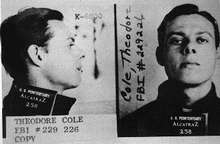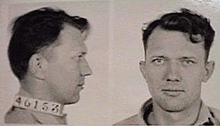Theodore Cole and Ralph Roe
| Theodore "Ted" Cole | |
|---|---|
 Theodore "Ted" Cole | |
| Born |
April 6, 1913 (age 103?) Pittsburg, Kansas |
| Status | Unknown |
| Ralph Roe | |
|---|---|
 Ralph Roe | |
| Born | February 5, 1906 (age 110?) |
| Status | Unknown |
Theodore "Ted" Cole (April 6, 1913)[1] and Ralph Roe (February 5, 1906)[2] took part in the second documented escape attempt from Alcatraz, in 1937. Although officials were quick to conclude they perished in the attempt, their remains were never found and their fate remains unknown, making the incident the first to shatter Alcatraz's reputation as an "escape-proof" prison.
Imprisonment
Cole and Roe, both convicted bank robbers (Cole went into Alcatraz for kidnapping also) in Oklahoma, had been caught during earlier, independent escape attempts from that state's McAlester Prison. Judged to be escape risks, they were both incarcerated in high-security Leavenworth Prison, then transferred to higher-security Alcatraz in 1936. They were given jobs working in the prison's Mat Shop, a facility at the northernmost point of the island, where discarded automobile tires were cut up and converted into rubber mats for the U.S. Navy.
Roe, an Oklahoma bank robber, was originally captured after a shootout with local police and FBI agents in Shawnee, Oklahoma on December 30, 1933. This same gun battle claimed the life of Roe's partner, Wilbur Underhill. Cole had been given a death sentence by means of an electric chair for his role in the robbery of a bottling works plant in Tulsa, Oklahoma.[3]
Escape and disappearance
On December 16, 1937, a dense fog swept through the San Francisco Bay, impeding marine traffic and reducing visibility on Alcatraz Island. Cole and Roe were working in a tire repair shop. A routine headcount at 12:50 p.m. showed all prisoners accounted for. At the next count, at 1:30 p.m., the two men were gone. Two iron bars and three heavy glass panes of a window in the shop had a hole 8 3⁄4 inches (22 cm) high and 18 inches (46 cm) long. Once through the window, they slipped down to the gate of a high wire fence, concealed by the fog. With a wrench taken from the tire shop, they forced the gate lock and dropped twenty feet to a beach. Their trail vanished at that point.
An exhaustive search of the island revealed nothing; guards found only the abandoned wrench. An extensive, multi-day search ensued; portions of the island were flooded with tear gas in an attempt to flush out the escapees, with no result. Subsequent investigation revealed that Cole and Roe had prepared for the escape well in advance, using a hacksaw blade to weaken the window bars, and disguising the damage with a mixture of grease and shoe polish. At the beach, the men presumably entered the water, relying on floats improvised from tires or fuel canisters. There was no evidence to suggest they had constructed or launched a raft.
Prison officials concluded that Cole and Roe drowned shortly after their escape. The swift ebb tides at the time, estimated at 7–9 knots, would have swept even an expert swimmer out of the bay and into the Pacific Ocean. The fog was so thick that it would have made it almost impossible for outside confederates to pick them up by boat, nor could the swimmers know whether or not they were swimming toward shore. It is most likely that Roe and Cole drowned, and that their bodies were swept out to sea with their flotation devices.
Despite their likely fate, police departments in the surrounding counties and the FBI followed up every tip and rumor. In the following days, months and years, there were various reports of sightings, but their validity is unknown. Two hitchhikers claimed to have seen Roe and Cole, and identified them to police by their photos. A 1941 San Francisco Chronicle report declared that the pair were living in South America, and a cab driver in Cole's hometown of Seminole, Oklahoma told police he had been shot by men he recognized as the two escapees.
The Seminole Producer reported on June 7, 1939:
| “ | Ted Cole, former Seminole youth, who escaped from Alcatraz prison with Ralph Roe in 1937 today was sought here by federal agents, more than 18 months after prison officials said they believed he had drowned in San Francisco Bay. The G-men here maintained their customary silence, but one Seminole man who had known both Cole and Roe at Leavenworth penitentiary said that he and other local residents had been questioned about the fugitives. Sandy Hood, in charge of Federal Bureau of Investigation operations in the sector, and Officer Smith of the G-men were in this area presumably working on the case with local officers. |
” |
Oklahoma officers seemed intentionally to try to not identify the escapees as they continued their hijacking spree in the Seminole, Tecumseh and Shawnee Oklahoma area. The Seminole Producer reported on June 24, 1939:
| “ | (Seminole) Police Chief Jake Sims and the highway patrol that have linked Ralph Roe, Alcatraz fugitive to a Tecumseh hijacking, are taking their time, a check of the hijacking victims showed today. At Oklahoma City, Mrs. Lois Daniels reported this noon that neither she nor her daughter, Mrs. E.J. Well, had been asked identify photographs of Roe. Mrs. Daniels saved $1,150 worth of rings by tossing them into the weeds while the hijacker took a $1,000 ring from Mrs. Well. Ed Talley of Oklahoma City who lost two $20 bills to the hijackers also said that he had not been asked to identify the pictures of Roe. |
” |
References
- ↑ – via ancestry.ca (subscription required)
- ↑ – via ancestry.ca (subscription required)
- ↑ "Swift Justice". The Daily Times. 1 Nov 1929. p. 14.
External sources
- Bruce, J. Campbell (2005). Escape from Alcatraz. Berkeley, California: Ten Speed Press. ISBN 1-58008-678-0.
- Ward, David; Kassebaum, Gene G. (2009). Alcatraz: The Gangster Years. Berkeley and Los Angeles: University of California Press. ISBN 0-520-25607-7.
- "Alcatraz Escape Attempts". AlcatrazHistory.com. Retrieved 3 July 2012.